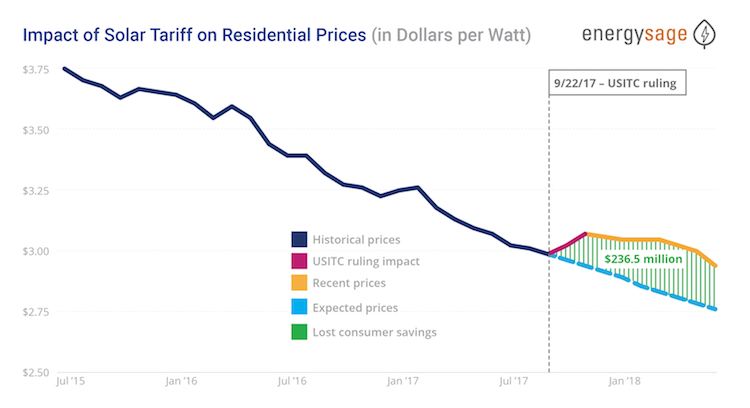It is an exciting time to be in the solar industry. This week marks the solar industry’s largest annual trade event: Solar Power International (SPI). EnergySage sent a team to Anaheim to see the latest and greatest technological advancements in the industry, discuss how federal and state policies impact the cost of solar in your state, and hear predictions from industry insiders for what to expect from solar in the next few years.
Technological advancements
SPI provides manufacturers with an opportunity to launch new product lines to a captive audience, and this week’s product announcements did not disappoint. The week began with Panasonic unveiling an upgraded line of higher efficiency panels to improve upon their existing products. These enhanced products provide higher output in both power and production, adding value to solar customers without expanding the footprint of the project.
A number of other companies displayed or debuted new panel products: bifacial panels that capture solar on both sides to increase the collection of the panel; modular tile- or shingle-type panel designs to reduce weight and installation time; and even a solar car roof from LG that is already in production with multiple automakers.
Equally important were the new or updated products that the panels themselves are connected to, from inverters and optimizers to electric vehicle chargers and home energy storage solutions. SolarEdge displayed an inverter plus electric vehicle product that ensures your car runs on clean energy by charging it directly with production from your solar system. APsystems introduced a quad microinverter that allows for up to four panels to be connected to the same inverter, a source for potential savings across a solar system. And home energy storage companies – from Sonnen to LG Chem, and Pika Energy to ElectrIQ – demonstrated a range of products at a variety of price points that can meet different homeowners’ needs with integrated storage solutions.
Policy impacts on the solar industry
Local, state and federal policy all can directly impact the cost and availability of solar for your home. As such, changes and trends in policy at all levels were top of mind throughout many educational sessions at SPI. The conference itself is convened by two solar industry trade association groups – the Smart Electric Power Alliance (SEPA) and the Solar Energy Industries Association (SEIA). However, these were hardly the only association groups discussing changes in solar policy across the country, with entities like IREC, the Interstate Renewable Energy Council, also presenting at SPI. The work these organizations do is paramount to the success of the industry, and it was incredibly helpful to hear the areas in which solar policy is actively changing.
At a high level, two key pieces of policy were front and center at the federal level: sunsetting tax incentives and the tariffs on imported solar panels and, now, imported Chinese inverters. Adding to this discussion, on Wednesday, EnergySage released our seventh Marketplace Intel report, analyzing trends in the industry over the last year for everything from pricing to the most quoted panels to solar customers’ adjacent energy interests. Importantly, we found that the Trump Administration’s tariffs on imported solar panels resulted to a $236.5 million tax on American residential solar customers over nine months.

The future of solar remains bright
The growth within the solar industry remains remarkable. So many of the people we spoke to are part of companies that are among the fastest growing in their sector of the solar industry, indicative of the larger, continuing upward trend in solar adoption across the country. Despite any political or supply chain roadblocks, people in the industry remain optimistic about the future of solar. The technological advancements unveiled at SPI are further proof of that faith in the industry.

Receive quotes for new products on EnergySage
To benefit from the updated products released or announced at SPI, register for the EnergySage Marketplace to receive free solar quotes for your house with the latest and greatest technology. Stay tuned for more content from SPI with detailed reviews of new products, as well as discussions of how new state policies will impact the cost of solar in your state.






